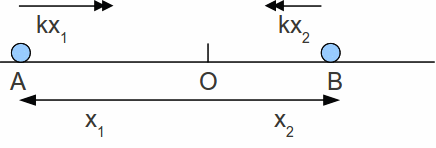Simple harmonic motion of a body is motion in a straight line about a point such that the acceleration of the body is always directed towards the equilibrium point, labelled O below, and the magnitude of the acceleration is proportional to the distance from the point. We may illustrate this in the diagram below, in which the double headed arrows indicate the acceleration.

In the diagram above the body is moving backwards and forwards about the point O.
At A the distance of the body from O is![]() and the acceleration is
and the acceleration is![]() towards O.
towards O.
At B the distance of the body from O is![]() and the acceleration is
and the acceleration is![]() towards O.
towards O.
At the point A it does not matter whether the particle is moving away from O or towards O: the acceleration is still![]() towards O. At the point B it does not matter whether the particle is moving away from O or towards O: the acceleration is still
towards O. At the point B it does not matter whether the particle is moving away from O or towards O: the acceleration is still![]() towards O – the acceleration is always directed towards O. Mathematically we may write
towards O – the acceleration is always directed towards O. Mathematically we may write![]() This equation states that the acceleration is proportional to the displacement from the equilibrium point and directed opposite to the displacement.
This equation states that the acceleration is proportional to the displacement from the equilibrium point and directed opposite to the displacement.
Simple harmonic motion is naturally related to motion in a circle.

We can use simple trigonometry to project motion in a circle onto the![]() axis in the diagram above using simple trigonometry:
axis in the diagram above using simple trigonometry:![]() where
where![]() is the rate of change of the angle with the
is the rate of change of the angle with the![]() axis, and is called the angular velocity.
axis, and is called the angular velocity.
If we differentiate this twice to get the acceleration, we obtain![]() Compare this with
Compare this with![]() to obtain
to obtain![]()